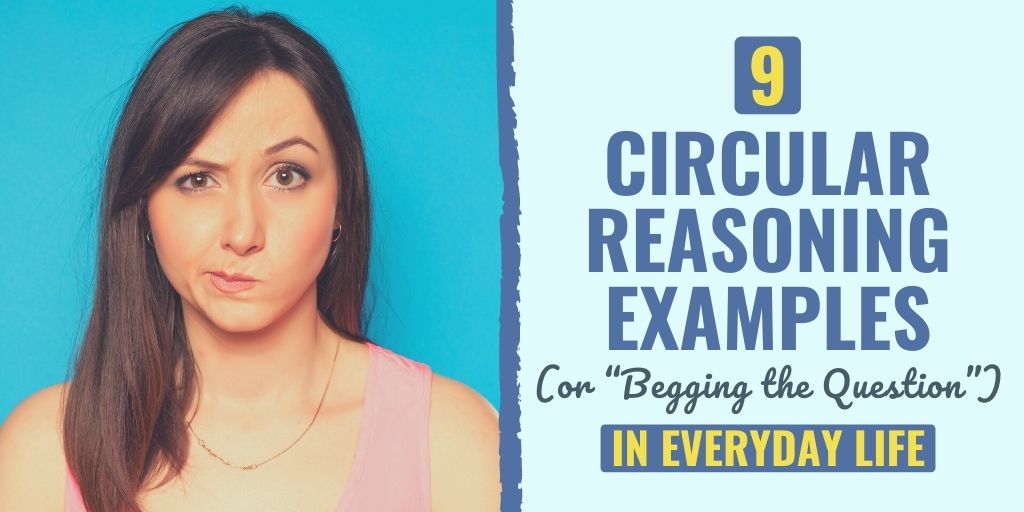There might be affiliate links on this page, which means we get a small commission of anything you buy. As an Amazon Associate we earn from qualifying purchases. Please do your own research before making any online purchase.
If you’re job hunting, you’re certainly not alone.
And if you are fresh out of college, you may be having a tough time competing in a job market with others who have extensive experience in your chosen field.
This is where a major frustration comes into trying to land a job. Often, companies will say they can’t hire you because you don’t have the experience that they’re looking for in a candidate. However, the only way you would get that experience would be by working at the company.
Essentially, the argument here is, “We can’t hire you because we have never hired you before.”
This is a real-life example of circular reasoning that resonates with many people right now–but, unfortunately, you probably don’t want to call out a potential employer for making a fallacious argument.
In this article, we are going to take a deeper look at what circular reasoning (or “begging the question”) is and then we will dive into 9 examples that you may come across in everyday life.
What is Circular Reasoning?
Circular reasoning is a type of argument in which the conclusion comes back to the premise without providing any outside proof, meaning both sides of the argument are making the same point. By using its own conclusion as a premise, the statement doesn’t offer any type of proof–instead, it declares the conclusion in another form, consequently asking the listener to accept it as being true without any evidential claims.
It often comes in a form that looks like this:
Premise: Claim A is true because Claim B is true.
Conclusion: Therefore, Claim B is true because Claim A is true.
Fooling someone with circular reasoning would require correctly assuming that they already believe that your conclusion is true. To go back to the job hunting example, the employer is assuming that the job hunter will think, “That’s true, I can’t work here because I don’t have any experience working here…so I must not be qualified.”
Now, we recognize that this logic doesn’t make sense because you can only gain experience by working there, and in order to work there you would need to be hired–but the speaker was able to circumvent any further questions.
So, who do you think would be the most likely to be convinced by this type of argument? It would be those who already believe the conclusion is true (…confirmation bias, anyone?).
But, if you don’t accept the claim, you won’t accept the reasoning behind it.
People often use this type of faulty reasoning when talking about an issue that is controversial, as a speaker assumes that the audience already agrees with the argument, claiming that it’s common sense. This can happen in many contexts, including relationships, politics, religion, marketing, medical decisions, and policy-making.
Circular reasoning may sound complicated, but it’s simple to understand with some real-world examples, so let’s take a look.
9 Circular Reasoning Examples (or “Begging the Question”) in Everyday Life
1. Religion
Circular reasoning is often brought up in religion because people’s beliefs are based on…beliefs. One common religious argument that falls into the category of circular reasoning is that the Bible is true, so you shouldn’t doubt it. This is used as a classic example of circular reasoning in many cases because regardless of whether or not the Bible is true, this statement is not a strong argument.
The person hearing the argument may be asking, “Well, how do we know God exists?” And the person making the claim responds by saying we know God exists because it says so in this book. The listener is then left to take the speaker’s word that the Bible is true and God exists because the speaker believes in the book (and therefore the listener should as well).
2. Catch-22
If you read the book Catch-22, you may be familiar with the circular reasoning that defines it. This novel portrays the absurdity of military life through the experiences of the US Army Air Force during World War II, who struggle to maintain their sanity while trying to meet their service requirements in order to go home from combat.
The circular reasoning argument in this classic story is that cognitively functional people have to fly in combat missions, even though they are dangerous. The idea of flying these combat missions is scaring people, so they claim to be mentally unstable so they can stay on the ground.
But the truth is, you would have to be of an unsound mind to be unafraid of flying in combat missions, because being afraid when facing danger is a sign of a rational mind. So, if you’re afraid, it shows that you are actually cognitively functional and therefore have to fly these combat missions that are scaring you and driving you crazy.
Essentially, soldiers who are exhibiting a fear response from going on combat missions have to fly in the missions because their demonstration of being traumatized proves they’re mentally sound.
3. Scam Emails
I’m sure you’ve gotten an email from someone overseas at some point, offering you a fortune…as long as you send some money to them first.
Of course, the author thinks you may question the validity of the offer since it’s so generous, so at the very end, the author writes, “I, prince Mubadola of Nigeria, assure you this is my message, and it is legitimate. You can trust this email and any further emails you receive from me.”
As the reader, you now “know” that the email is legitimate because it says that it is in the email. By asserting the conclusion in another form, the author is asking the recipient of the email to accept it as the truth.
4. “Of course doing drugs is illegal, it’s against the law!”
The premise of this argument (that doing drugs is illegal) is the same as the reasoning (it’s against the law).
This argument is circular because it returns to the beginning: It’s against the law to do drugs because doing drugs is illegal, and, it's illegal to do drugs because it’s against the law. The listener needs some additional evidence to escape the circular reasoning, regardless of whether or not the claim is true.

5. Women’s Rights
“Women should have access to abortion services, so abortion should be legal and available.”
This is a similar argument to the circular reasoning argument about the legality of drugs. This statement causes the listener to ask, “How can you be sure?” There is no valid evidence aside from the assertion that claim A proves conclusion B.
6. Societal Norms
There are many societal norms that could be argued using circular reasoning. For example, “Most people get married because getting married is the norm. It is the norm to get married because most people marry.”
This argument could go in circles all day without offering any actual evidence as to why people get married or why it is a societal norm.
7. “Happiness is the principal value for all humans because all other values are inferior to it.”
As you can see, the “because” in this sentence just brings the reader back to the beginning. It doesn’t offer any new information or evidence that the statement is true.

The speaker here is making an attempt to avoid taking on the burden of further proving the premise of their argument by basing it on the assumption (or hope) that the listener already believes the conclusion is true. So in this case, the speaker is inferring that the listener believes that there are no values that are more important than happiness. And, that certainly may not be the case.
8. “Smoking causes cancer because the smoke from cigarettes is a carcinogen.”
This essentially says that smoking causes cancer because smoke is cancerous. This is an example of when the premise and conclusion are both indeed true, however, the relational structure of the two statements when used as an argument is considered to be circular reasoning.
If another factor were to be brought in, such as:
“Smoking causes cancer because it releases over 5,000 chemicals into the body that damage one’s DNA and destroy cancer-protecting elements in cells.”
Then the circle would be broken.
9. “Minority’s rights are just as protected as the rights of the majority because the majority’s rule is not valued any more than the rights of minorities.”
The circular structure of this argument attempts to block further dialogue and prevent the listener from responding by asking legitimate questions looking for further evidence of the claim. The premise of this argument is the same as–and therefore equally as questionable as–its conclusion.
This topic is more complex than the conclusion that the speaker is offering. A statement that would avoid circular reasoning would be: “Instances that involve this type of debate are addressed on a case-by-case basis to come to a conclusion that allows neither the majority rule nor minority rights to undergo irreparable harm. The majority rule and minority rights must both be preserved to maintain a fair and just constitutional democracy.”
Learn About Other Logical Fallacies
- 5 Appeal to Nature Fallacy Examples in Media and Life
- 6 Outcome Bias Examples That Can Negatively Impact Your Decisions
- 7 Self-Serving Bias Examples You See Throughout Life
- 7 Omission Bias Examples That Negatively Impact Your Life
- 6 Authority Bias Examples That Might Impact Your Decisions
- 5 Burden of Proof Fallacy Examples
- 5 Appeal to Tradition Fallacy Examples in Life
- 5 Appeal to Authority Logical Fallacy Examples
- 7 False Cause Fallacy Examples
- 7 Appeal to Ignorance Fallacy Examples
- 7 Appeal to Common Sense Logical Fallacy Examples
- 5 Post Hoc Fallacy Examples (and How to Respond to This Argument)
- Gambler’s Fallacy: 5 Examples and How to Avoid It
- 5 Appeal to Anger Fallacy Examples Throughout Life
- 7 Halo Effect Bias Examples in Your Daily Life
- 7 Poisoning the Well Examples Throughout Your Life
- 7 Survivorship Bias Examples You See in the Real World
- 7 Dunning Kruger Effect Examples in Your Life
- 7 Either Or (“False Dilemma”) Fallacy Examples in Real Life
- 5 Cui Bono Fallacy Examples to Find Out “Who Will Benefit”
- 6 Anchoring Bias Examples That Impact Your Decisions
- 7 Virtue Signaling Examples in Everyday Life
- 7 Cherry Picking Fallacy Examples for When People Ignore Evidence
- 9 Appeal to Emotion Logical Fallacy Examples
- 9 Appeal to Pity Fallacy (“Ad Misericordiam”) Examples in Everyday Life
- 9 Loaded Question Fallacy Examples in Life and Media
- 9 Confirmation Bias Fallacy Examples In Everyday Life
- 9 Bandwagon Fallacy Examples to Prevent Poor Decisions
- 5 Red Herring Fallacy Examples to Fight Irrelevant Information
- 9 Middle Ground Fallacy Examples to Spot During an Argument
- 5 False Equivalence Examples to Know Before Your Next Argument
- 7 Hasty Generalization Fallacy Examples & How to Respond to Them
- 6 Straw Man Fallacy Examples & How You Can Respond
- 6 False Dichotomy Examples & How to Counter Them
- 7 Slippery Slope Fallacy Examples (And How to Counter Them)
- What is the Planning Fallacy?
- How to Overcome the “Sunk Cost Fallacy” Mindset
Final Thoughts on Circular Reasoning
The best way to prevent people from being able to make circular reasoning arguments is to ask for more evidence of their claim. Whether you’re on the receiving end of the argument or you’re making a claim that could potentially be regarded as circular reasoning, adding outside proof can put an end to this loop. Keeping an open mind based on outside evidence is critical when trying to prevent an argument from becoming circular.
Keep these examples in mind when you think you may be in a conversation that is using circular reasoning in some way to prove a point, and consider asking for (or providing) more evidence for a claim.
Finally, if you want a simple process to counter the logical fallacies and cognitive biases you encounter in life, then follow this 7-step process to develop the critical thinking skills habit.

Connie Mathers is a professional editor and freelance writer. She holds a Bachelor's Degree in Marketing and a Master’s Degree in Social Work. When she is not writing, Connie is either spending time with her daughter and two dogs, running, or working at her full-time job as a social worker in Richmond, VA.


